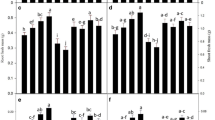Abstract
Brassinosteroids promote the growth of plants and are effective in alleviating adverse effects of abiotic stresses such as salinity and drought. Under saline conditions, improvement in grain yield is more important than simple growth. Previously it was found that although foliar application of brassinosteroids improved growth of wheat plants, it did not increase grain yield. In present study, influence of root applied 24-epibrassinolide was assessed in improving growth and yield of two wheat cultivars. Plants of a salt tolerant (S-24) and a moderately salt sensitive (MH-97) were grown at 0 or 120 mM NaCl in continuously aerated Hoagland’s nutrient solution. Different concentrations of 24-epibrassinolide (0, 0.052, 0.104, 0.156 μM) were also maintained in the solution culture. Exogenous application of 24-epibrassinolide counteracted the salt stress-induced growth and grain yield inhibition of both wheat cultivars. Of the varying 24-epibrassinolide concentrations used, the most effective concentrations for promoting growth were 0.104 and 0.052 μM under normal and saline conditions, respectively. However, root applied 0.052 μM 24-epibrassinolide enhanced the total grain yield and 100 grain weight of salt stressed plants of both cultivars and suggested that total grain yield was mainly increased by increase in grain size which might have been due to 24-epibrassinolide induced increase in translocation of more photoassimilates towards grain. Growth improvement in both cultivars due to root applied 24-epibrassinolide was found to be associated with improved photosynthetic capacity. Changes in photosynthetic rate due to 24-epibrassinolide application were found to be associated with non-stomatal limitations, other than photochemical efficiency of PSII and photosynthetic pigments. Leaf turgor potential found not to be involved in growth promotion.




Similar content being viewed by others
References
Ali B, Hayat S, Ahmad A (2007) 28-Homobrassinolide ameliorates the saline stress in chickpea (Cicer arietinum L.). Environ Exp Bot 59:217–223. doi:10.1016/j.envexpbot.2005.12.002
Amzallag GN (2002) Brassinosteroids and metahormones: evidence for their specific influence during critical period in sorghum development. Plant Biol 4:656–663. doi:10.1055/s-2002-37397
Anuradha S, Rao SSR (2003) Applications of brassinosteroids to rice seeds (Oryza sativa L.) reduce the impact of salt stress on growth, prevented photosynthetic pigment loss and increased nitrate reductase activity. Plant Growth Regul 40:29–32. doi:10.1023/A:1023080720374
Arnon DT (1949) Copper enzyme in isolated chloroplasts, polyphenaloxidase in Beta vulgaris. Plant Physiol 24:1–15
Ashraf M (2001) Relationships between growth and gas exchange characteristics in some salt-tolerant amphidiploid Brassica species in relation to their diploid parents. Environ Exp Bot 45:155–163. doi:10.1016/S0098-8472(00)00090-3
Ashraf M (2003) Relationships between leaf gas exchange characteristics and growth of differently adapted populations of Blue panic grass (Panicum antidotale Retz) under salinity or waterlogging. Plant Sci 165:69–75. doi:10.1016/S0168-9452(03)00128-6
Ashraf M (2004) Some important physiological selection criteria for salt tolerance in plants. Flora 199:361–376
Baker NR (1991) A possible role for photosystem II in environmental perturbations of photosynthesis. Physiol Plant 81:563–570. doi:10.1111/j.1399-3054.1991.tb05101.x
Clouse SD, Sasse JM (1998) Brassinoseroides essential regulators of plant growth and development. Annu Rev Plant Physiol Plant Mol Biol 49:427–451. doi:10.1146/annurev.arplant.49.1.427
Dubey RS (2005) Photosynthesis in plants under stressful conditions. In: Pessarakli M (ed) Hand book photosynthesis, 2nd edn. CRC Press, Taylor and Francis Group, New York, pp 717–737
Fariduddin Q, Ahmad A, Hayat S (2003) Photosynthetic response of vigna radiata to presowing seed treatment with 28-homobrassinolide. Photosynthetica 41:307–310. doi:10.1023/B:PHOT.0000011968.78037.b1
Fujii S, Saka H (2001) Distribution of assimilates to each organ in rice plants exposed to low temperature at the ripening stage and effect of brassinolide on the distribution. Plant Prod Sci 4:134–136
Goetz M, Godt DE, Roitsch T (2000) Tissue-specific induction of the mRNA for an extra-cellular invertase isoenzyme of tomato by brassinosteroids suggests a role for steroid hormones in assimilate partitioning. Plant J 22:515–522. doi:10.1046/j.1365-313x.2000.00766.x
Grieve MC, Scott ML, Francois EL, Mass VE (1992) Analysis of main-spike yield components in salt-stressed wheat. Crop Sci 32:697–703
Haubrick LL, Assmann SM (2006) Brassinosteroids and plant function: some clues, more puzzles. Plant Cell Environ 29:446–457. doi:10.1111/j.1365-3040.2005.01481.x
Hayat S, Ahmad A, Mobin M, Hussain A, Faridduddin Q (2000) Photosynthetic rate, growth and yield of mustard plants sprayed with 28-homobrassinolide. Photosynthetica 38:469–471. doi:10.1023/A:1010954411302
Morillon R, Catterou M, Sangwan RS, Sangwan BS, Lassalles JP (2001) Brassinolide may control aquaporin activities in Arabidopsis thaliana. Planta 212:199–204. doi:10.1007/s004250000379
Munns R (2005) Genes and salt tolerance: bringing them together. New Phytol 167:645–663
Mussig C (2005) Brassinosteroid-promoted growth. Plant Biol 7:110–117. doi:10.1055/s-2005-837493
Nakajima N, Toyama S (1999) Effects of epibrassinolide on sugar transport and allocation to the epicotyl in cucumber seedlings. Plant Prod Sci 2:165–171
Nátr L, Lawlor DW (2005) Photosynthetic plant productivity. In: Pessarakli M (ed) Hand book of photosynthesis, 2nd edn. CRC Press, New York, pp 501–524
Petzold U, Peschel S, Dahse T, Adams G (1992) Stimulation of C14-sucrose export in Vicia faba plants by brassinosteroids, GA3 and IAA. Acta Bot Neerl 41:469–479
Raza SH, Athar HR, Ashraf M (2006) Influence of exogenously applied glycinebetaine on the photosynthetic capacity of two differently adapted wheat cultivars under salt stress. Pak J Bot 38(2):341–351
Robinson SP, Downton WJS, Millhouse JA (1983) Photosynthesis and ion content of leaves and isolated chloroplasts of salt-stressed spinach. Plant Physiol 73:238–242
Sakurai A, Yokota T, Clouse SD (1999) Brassinosteroids. Steroidal plant hormones. Springer, Tokyo
Sasse JM (1997) Recent progress in brassinosteroid research. Physiol Plant 100:696–701. doi:10.1111/j.1399-3054.1997.tb03076.x
Shahbaz M, Ashraf M, Athar HR (2008) Does exogenous application of 24-epibrassinolide ameliorate salt induced growth inhibition in wheat (Triticum aestivum L)? Plant Growth Regul 55:51–64. doi:10.1007/s10725-008-9262-y
Snedecor GW, Cochran GW (1980) Stat Method, 7th edn. The Iowa State University Press, Ames
Strasser RJ, Srivastava A, Govindjee (1995) Polyphasic chlorophyll ‘a’ fluorescence transients in plants and cyanobaderia. Photochem Photobiol 61:32-42. doi:10.1111/j.1751-1097.1995.tb09240.x
Yu JQ, Huang LF, Hu WH, Zhou YH, Mao WH, Ye SF et al (2004) A role of brassinosteroid in regulation of photosynthesis in Cucumus sativus. J Exp Bot 55:135–1143. doi:10.1093/jxb/erh124
Author information
Authors and Affiliations
Corresponding author
Rights and permissions
About this article
Cite this article
Ali, Q., Athar, HuR. & Ashraf, M. Modulation of growth, photosynthetic capacity and water relations in salt stressed wheat plants by exogenously applied 24-epibrassinolide. Plant Growth Regul 56, 107–116 (2008). https://doi.org/10.1007/s10725-008-9290-7
Received:
Accepted:
Published:
Issue Date:
DOI: https://doi.org/10.1007/s10725-008-9290-7




